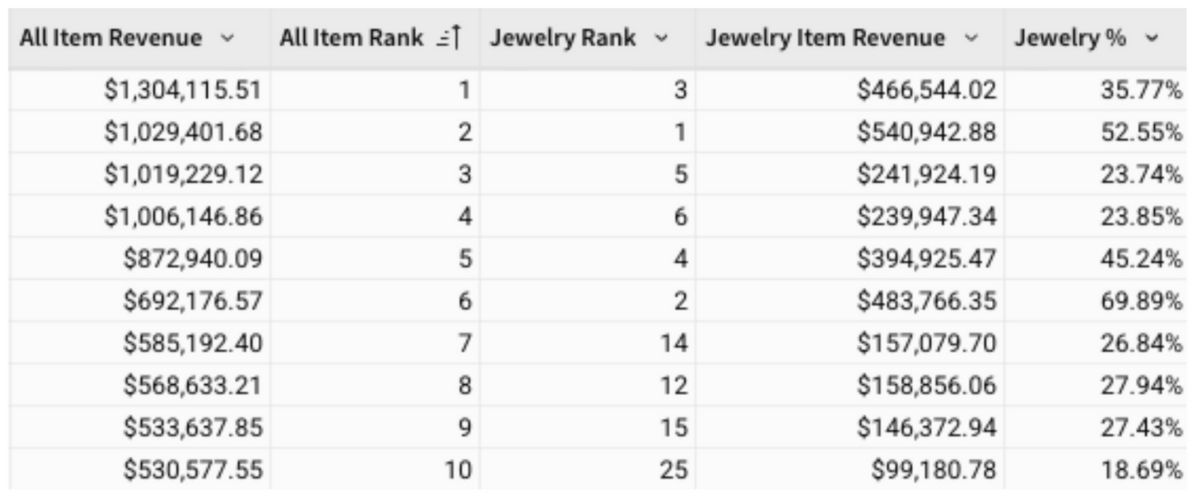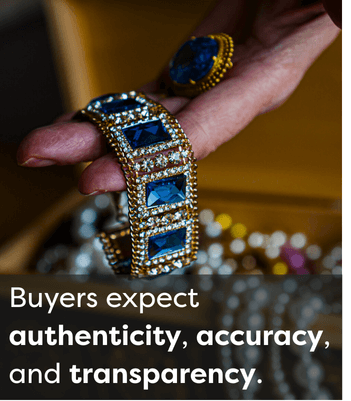The used jewelry resale market is projected to more than double from $2.21 billion in 2024 to $5.53 billion by 2033, according to Business Research Insights. Secondhand organizations know the power of jewelry to their business. Building a strong jewelry program today positions your organization to tap into this rapidly expanding market and maximize future returns.
For many of Upright’s top-performing resale organizations, jewelry accounts for about 20% or more of their total revenue. And the connection is clear:
When jewelry sales rise, overall revenue follows.

For organizations working in secondhand retail, this means jewelry should not be treated as a side category or “nice to have.” It’s a cornerstone for long-term success. Even if you start small, a structured jewelry program can scale into one of your largest and most profitable departments.
In this article, we’ll walk through the biggest takeaways from our recent Jewelry Resale 101 Master Class with Thermo Fisher Scientific, covering the workflows, tools, and strategies that set the best programs apart.
Why Jewelry Matters in Resale
Jewelry resale holds a unique place in e-commerce. Unlike many categories, jewelry has:
- High value per item: A single ring or necklace can generate as much revenue as dozens of clothing items.
- Consistent buyer demand: Jewelry remains timeless. Shoppers look for gold, silver, designer names, and vintage styles year-round.
- Efficient storage and shipping: Jewelry is small and easy to ship, especially when compared to heavier items like electronics or large collectibles.
These advantages make jewelry one of the most reliable revenue drivers in resale. At the same time, it requires extra care. Buyers expect authenticity, accuracy, and transparency. Teams that invest in strong jewelry operations are the ones that see jewelry become a steady revenue stream rather than a challenge.

Four Keys to Jewelry Resale Success
These are the four pillars that every jewelry program should master:
1. Build a Strong Workflow
A successful jewelry program starts with an efficient workflow. Jewelry can easily pile up or get lost without a clear system. The key is to set up sorting categories that help your team quickly identify value and process items.
A proven setup includes:
- Watches
- Gold and silver (for purity testing)
- Vintage or antique pieces
- Designer brands
- Costume jewelry
From there, subcategories like goldtone, silvertone, or Southwest styles can be added, but only if they’re worth the time based on price per pound.
A strong sorting process ensures that valuable pieces don’t slip into low-value bins. It also allows your team to handle higher volumes without bottlenecks. If you’re dealing with a backlog, multiple people can work together to speed up sorting. If you have low volume, one or two people may be enough.

2. Test with Accuracy
Testing is where trust is built. Buyers need to know that what you list is authentic. Inaccurate testing can erode trust quickly and cut into profits.
Traditionally, many sellers used acid tests to check metal purity. While common, acid testing is messy, destructive, and often unreliable. A better solution is scientific testing. Thermo Fisher’s Niton™ XRF Analyzer provides fast, safe, non-destructive results. It reads the exact composition of a piece, helping teams avoid costly mistakes.
Jewelry identification can be broken into five simple steps:
- 1. Look for markings (like “925” for sterling silver or “14k” for gold).
- 2. Check quality and construction such as well-made clasps, smooth finishes, and prong-set stones signal higher value.
- 3. Examine stones and tarnish. Real gemstones often have tiny natural markings, while fake stones look uniform. Tarnish can also give clues: pure gold does not tarnish, silver often turns black or gray, and base metals may show green, blue, or chalky residue over time
- 4. Consider age and materials. Bakelite, uranium glass, and other materials can signal collectible value.
- 5. Use professional testing tools for confirmation.
Want to sharpen your jewelry skills?
Download our free Jewelry Identification & Testing Guide to learn how to spot markings, evaluate construction, and test metals with confidence.


3. Create Listings That Convert
The way you present jewelry online makes the difference between a quick sale and an item sitting unsold. Buyers rely on photos and descriptions to make decisions.
Photography best practices include:
- Use clear, detailed photos with good lighting.
- Capture close-ups of hallmarks, clasps, and unique features.
- Show any damage honestly to build buyer trust.
Think of your photos and descriptions as your salesperson. They answer questions before a buyer asks.
Listing details should cover:
- Brand or maker’s mark
- Metal type and purity
- Stone type
- Dimensions and weight
- Condition notes

Consistency is key. Using standardized templates helps teams list faster and ensures no important details are left out.

4. Use Data to Guide Strategy
Finally, the most successful resale organizations use data to drive their jewelry strategy. Reports show that jewelry sales have one of the strongest correlations to overall revenue growth. “…reputable buyers typically offer scrap value that’s a percentage of the melt value – usually between 70-90%…” (Thompson)

One of the clearest insights is the difference between scrap and non-scrap jewelry:
- Scrap jewelry (like broken pieces) averages about 87% of melt value.
- Small-lot or individual non-scrap pieces average closer to 93% of melt value.
That 6% difference may sound small, but over time it adds up to thousands of dollars in extra revenue.
The practical takeaway?
- Always list silver when possible.
- Keep scrap limited to truly broken items.
- Adjust strategies based on karat weight and condition.
By leaning on data, sellers can make smarter decisions about what to list individually, what to bundle, and what to scrap.

Start Small, Scale Big
You don’t need a massive setup to start a jewelry program. Many organizations begin with a single sorting station, a simple testing tool, and one or two people listing items online.
Over time, this small start can scale into a full department. As volume grows, teams add:
- More detailed sorting categories
- Staff trained in testing and photography
- Reporting systems to track profitability
- Standardized workflows to handle higher throughput

Scaling with the Right Support
Scaling a jewelry program requires expertise. That’s why Upright Labs offers the Professional Services Jewelry Program. This service is designed to help teams unlock their full potential.
Through the program, teams receive support with:
- Workflow design tailored to jewelry
- Staff training on testing, photography, and listing
- Access to reporting and marketplace insights
Our team works with you to grow your jewelry program faster and make it more profitable at any stage.

Ready to Unlock Growth?
Jewelry is more than an add-on category. It’s a proven growth engine for resale. With the right operations, any organization can turn jewelry into a cornerstone of revenue.
Now is the time to take the next step.
Connect with our Account Management team to learn more about Upright Labs’ Professional Services Jewelry Program.
Email [email protected] or view program details on our website.


